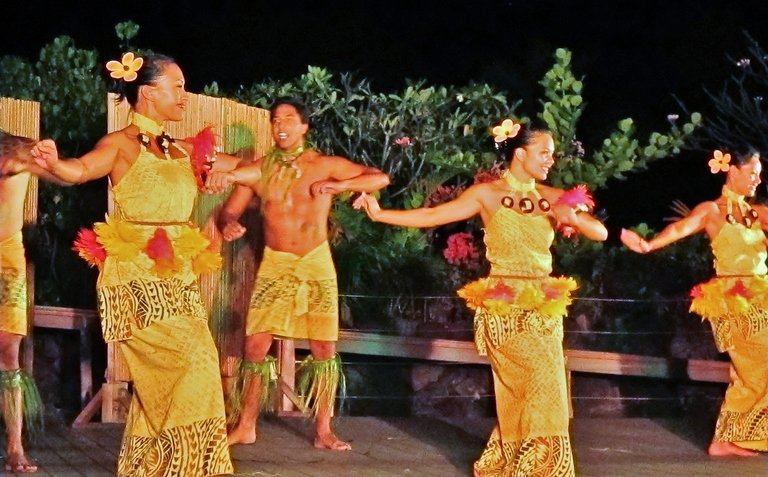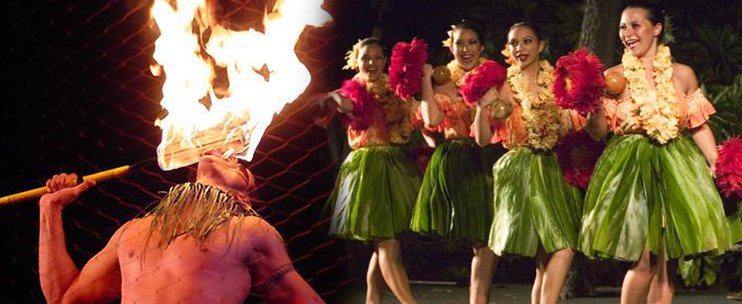Ultimate Guide to Big Island Luaus
A luau (Hawaiian: lūʻau, pronounced as “LOO-ow”) represents the heart and soul of Hawaiian culture, offering an unforgettable blend of food, entertainment, and tradition. For most visitors to the Big Island, attending a luau means indulging in a feast of Hawaiian cuisine while enjoying captivating cultural performances from Hawaii and other Polynesian regions, complete with music, hula dances, and captivating storytelling.
The origins of the luau date back to 1819 when King Kamehameha II abolished the practice of men and women eating separately. He symbolically ate with women, marking the inception of the luau as we know it today. This cherished tradition has endured for nearly two centuries, making it an integral part of Hawaiian history and culture.
Frequently Asked Luau Questions
Q: What is the best luau on the Big Island?
The Big Island boasts ten distinct luau shows, each with its unique offerings. For instance, the Voyagers of the Pacific Luau in Kona combines affordability with spectacular ocean views, the Legends of Hawaii Luau at the Hilton is renowned for its exceptional show (though it can be pricey), and the Mauna Kea Luau is a favorite for its delectable cuisine. Keep reading to learn more about all of the luaus on the Big Island.
Q: How much does a luau cost?
The cost of attending a luau on the Big Island typically ranges from approximately $130 to $180 per person for the basic package. Additional upgrades, such as preferred seating, a group photo, and a traditional flower lei, can add an extra $30 to the price. Children between 4 and 12 years old often receive substantial discounts, and children under 4 years old usually attend for free.
Q: What is the best luau for families?
While all luau shows offer special activities for children before the buffet, the Island Breeze Luau is particularly well-suited for families. It strikes a perfect balance between family-friendly entertainment and affordability.
Q: How long does a luau last?
Luau events typically take place in the evening, starting around dusk and concluding a few hours after sunset. This timing ensures optimal lighting conditions for both dining and the show, which often features mesmerizing fire dancers.
List of All Luaus on the Big Island
The Big Island currently hosts eight active luau shows, mainly situated on resort properties along the Kohala coast and around Kailua Kona:
1. Voyagers of the Pacific Luau (Kona): Held at the Royal Kona Resort in downtown Kona, this luau offers convenience and stunning ocean views. The event includes pre-show entertainment, an imu ceremony, an all-you-can-eat buffet, and complimentary drinks.
2. Island Breeze Luau (Kona): Located at the Marriott King Kamehameha Kona Beach Hotel, this luau combines high-quality performances, delicious food, and an excellent location. It includes activities like learning hula and getting a Hawaiian tattoo.
3. Hawaiʻi Loa Luʻau (Kohala Coast): Held at the Fairmont Orchid resort on the Kohala coast, this luau tells the story of Hawaiians' arrival in Hawai’i through engaging performances, cultural activities, and a dinner buffet.
4. Sunset Luau at the Waikoloa Beach Marriott Resort (Kohala Coast): This popular luau features a buffet with contemporary and Hawaiian dishes, a full open bar, and breathtaking sunset views at the Waikoloa Beach Marriott Resort & Spa.
5. Legends of Hawaii Luau (Kohala Coast): Organized at the Hilton Waikoloa Village resort, this luau offers an impressive show but takes place in an open amphitheater, unlike many other luaus with outdoor settings.
6. Mauna Kea Luau (Kohala Coast): Hosted at the Mauna Kea Beach Hotel, this luau stands out with its festive atmosphere, use of wooden plates, and "aloha attire" dress code. It offers an entertaining show and good food.
7. Hale Hoaloha Lūʻau (Mauna Lani, Auberge Resorts Collection): Organized by Big Island Breeze Productions, this new luau has received positive reviews. It's held at Mauna Lani (Auberge Resorts Collection) every Friday.
8. Feast & Fire Lūʻau (Outrigger Kona Resort & Spa): This luau is performed by the renowned Lim Family of Kohala and features a buffet-style meal with Pan-Pacific cuisine and authentic performances.
Please note that availability and details may change, so it's advisable to check with the respective luau organizers for the most up-to-date information and reservations.
What Happens During a Luau?
A typical luau lasts approximately 2.5 hours and typically follows this format:
Cultural Demonstrations/Activities (Approx. 30 Minutes): The evening kicks off with around half an hour of child-friendly and cultural demonstrations and activities. This is a great opportunity to learn about Hawaiian traditions and history.
Dinner Buffet (Approx. 1 Hour): Guests are invited to indulge in a diverse dinner buffet, featuring a variety of Hawaiian and Polynesian dishes. The menu often includes the iconic Kalua pig, poi, chicken long rice, laulau, lomilomi salmon, haupia (coconut pudding), and poke.
Entertainment (Approx. 1 Hour): The highlight of the luau is the one-hour show, which encompasses storytelling, hula dances, and mesmerizing fire dancers. The performances depict Hawaiian culture and history in a captivating way.
Things to Keep in Mind About Attending a Luau
Here are some essential considerations for those planning to attend a luau:
1. Shared Tables: Luau events often host hundreds of guests, and you may be seated at a large table with strangers. Access to the buffet is typically granted table by table, so there may be some waiting time to fill your plate. Consider upgrading to "preferred seating" if you want early access to the buffet line.
2. Price: Luau tickets can be relatively expensive, starting at $130 per person. While the food is generally tasty, you can find better-value meals at local restaurants. Some luaus offer a "show-only" option at a reduced cost.
3. Parking: Most luaus are held at hotel or resort grounds, where parking may not be included in the ticket price. Be prepared to pay for parking if you're not staying at the same hotel or resort or if free parking is not available nearby.
If your primary goal in attending a luau is to immerse yourself in Hawaiian culture and you're less concerned about the food, you might consider the "show-only" option or explore free hula shows and cultural events held throughout the Big Island.
For those enthusiastic about the complete luau experience, read on for details about all the luau options available on the Big Island. If you plan to visit other Hawaiian islands, we also recommend checking out our comparison articles for luau shows on Oʻahu, Kauaʻi, and Maui.
7 Typical Luau Foods
A luau experience is incomplete without savoring the delectable array of local dishes. Here are seven iconic luau foods you're likely to encounter:
1. Kalua Pig (or Pork): This centerpiece of the luau consists of pork cooked in an imu (underground oven) and shredded. It's a must-try and a giant in Hawaiian cuisine.
2. Poi: A traditional Hawaiian "pudding" made from taro root, poi has a starchy and slightly sour taste due to light fermentation during preparation. It's a unique culinary experience.
3. Chicken Long Rice: Inspired by Chinese cuisine, this dish includes chicken soup, clear noodles, chicken, and ginger.
4. Laulau: A delicious treat featuring pork, chicken, or fish wrapped in luau (taro) leaves and steamed. The result is tender, juicy, and flavorful.
5. Lomilomi Salmon: A traditional salad or side dish made with fresh tomato, salmon, and onion.
6. Haupia: A sweet dessert made from coconut milk and cornstarch, offering a delightful finish to your meal.
7. Poke: A beloved Hawaiian dish consisting of raw fish marinated in soy sauce, onions, and lemon (or other marinades). It's a must-try local specialty.
You don't need to attend a luau to sample these foods; many are available at local supermarkets and Hawaiian restaurants. For more information on local specialties and where to find them, refer to our list of Hawaiian foods.
What Is Hula?
Hula is a captivating form of dance accompanied by chants or songs. It originated in Hawaii and serves as a means of storytelling. Hula dancers use intricate hand and body movements to convey the words of the songs or chants. In Hawaii's history, where written language was absent, hula played a crucial role in preserving culture, history, genealogy, and mythology.
Nowadays, hula has become a symbol of Hawaiian culture and is enjoyed by visitors as well. During your visit to the Hawaiian Islands, you'll have the opportunity to witness mesmerizing hula performances that showcase the richness of Hawaiian heritage.
Two Different Styles of Hula:
Modern hula can be categorized into two distinct styles: Hula Kahiko and Hula Auana.
Hula Kahiko: This is the traditional or ancient style, often referring to hula compositions dating back to before 1894. Hula Kahiko is performed without modern instruments and is characterized by traditional costumes, a more austere appearance, and a deep reverence for spiritual roots. When people speak of "traditional hula," they are usually referring to Hula Kahiko.
Hula Auana: This is a contemporary form of hula that reimagines old stories with new choreography and music, incorporating modern instruments like the ukulele, guitar, steel guitar, bass, or piano.
Hula remains a dynamic and cherished art form that beautifully embodies the spirit and heritage of Hawaii.
We hope this comprehensive guide to Big Island luaus and Hawaiian culture enhances your understanding and appreciation of these treasured traditions. Enjoy your visit to the Big Island, and may your luau experience be a memorable one!





